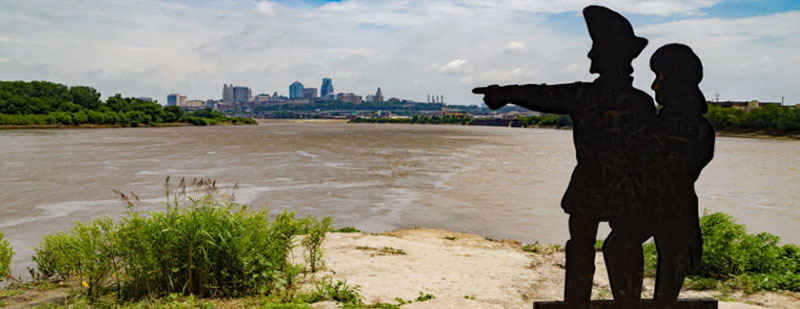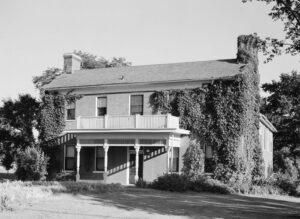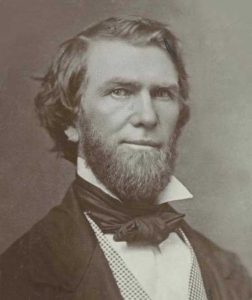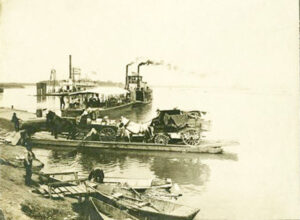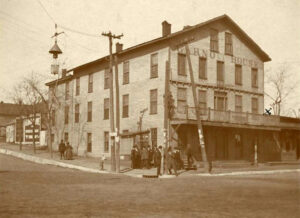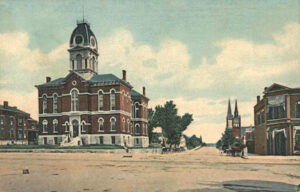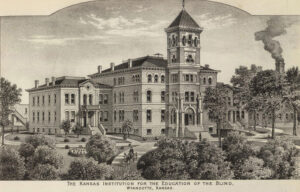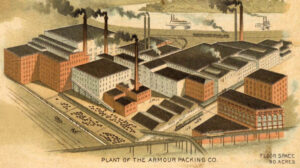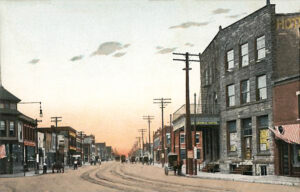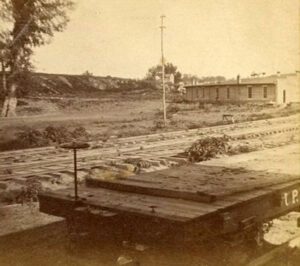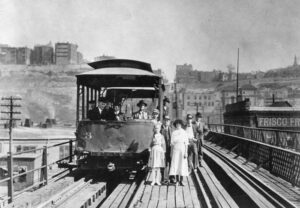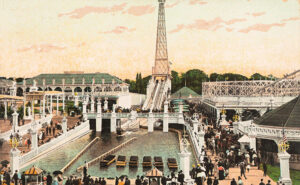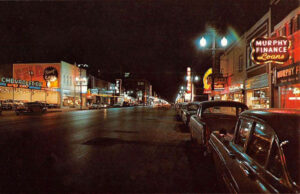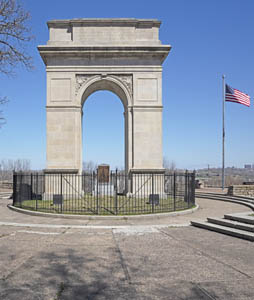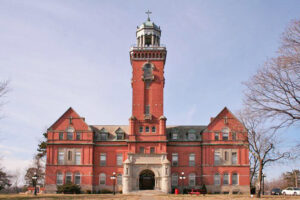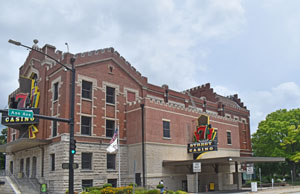Kansas City, Kansas, is the county seat of Wyandotte County and is located at Kaw Point, at the junction of the Kansas and Missouri Rivers in the extreme eastern part of the county. It is an inner suburb of the older and more populous Kansas City, Missouri, after which it is named. The Missouri River separates the two cities. As of the 2020 census, the city’s population was 156,607, making it one of four principal cities in the Kansas City metropolitan area. Kansas City, Kansas, abbreviated as KCK, is the third-most populous city in the state of Kansas.
On June 26, 1804, Lewis and Clark passed through the territory on their expedition to the Pacific Coast. They landed on the neck of land between the two rivers called Kaw Point and rested for two days, making observations and overhauling equipment. Two years later, after crossing the Rocky Mountains to the Pacific Ocean, they stopped at this point again on their return voyage. On Monday, August 15, 1806, Clark wrote in his diary:
“The Kansas is very low at this time. About a mile below it, we landed to view the situation of a high hill, which has many advantages for a trading house or fort, while on shore, we gathered great quantities of pawpaws and shot an elk. The low grounds are now delightful, and the country exhibits a rich appearance.”
This was the first written description of the territory. Twelve years later, it was made part of the reservation granted to the Delaware Indians. Reverend Thomas Johnson established the Shawnee Methodist Mission in 1830 at Turner, Kansas. In 1839, it was relocated southward to present-day Fairway, Kansas, in Johnson County. As its name suggests, the mission served the local Shawnee tribe, which had been forcibly relocated to Kansas Territory after a treaty in 1825.
The Wyandot, the last of the emigrant tribes, came from Sandusky, Ohio, as a band of 700 who were educated and, in many instances, cultured people. Intermarried with whites from generations back, they were more white than Indian; their leaders were men of influence and ability. They bought the land upon which the town of Wyandotte was subsequently laid out. J.W. Armstrong, the interpreter, built a log cabin in the fall of 1843 and occupied it in December of that year, the first house erected on the townsite. The first religious organization in the town was the Methodist Mission, which was established the same year by James Wheeler, a missionary sent out by the North Ohio Conference.
Within 12 months, despite flood and sickness and the delay of the Federal Government in paying them for their Ohio reservation improvements, they had built a school, the first free school in Kansas; a church, the organization of which they brought from Ohio; a store owned in common by the nation; and a council house in which they were to take far-reaching action. The mission church was completed in 1844.
When their church was divided in 1848, 135 of the 200 members espoused the Northern cause. Thus, this little Indian Settlement was staged as a preliminary to the national conflict.
The Wyandot were farmers devoted to rural pursuits rather than urban practices, and the little city grew very slowly until 1849, when the California Gold Rush placed it on the great highway to the Pacific Ocean, an alarming situation for Wyandot leaders. From past experiences, they knew that the white men invading their precincts, sooner or later, would covet their lands and that what white men wanted, they would obtain. They could only increase the value and obtain the best price possible. To accomplish this, they needed to induce white men to settle among them, and to bring white men, they must assume a Territorial status.
With this objective, they met on October 12, 1852, in their council house and elected Abelard Guthrie, a white man married into the tribe, as a delegate to the Thirty-second Congress. Guthrie was not admitted to Congress, but his presence in Washington D.C. forced the Territorial question, which Wyandot leaders were fully aware of. On July 26, 1853, they met to take the more compelling action of organizing Kansas and Nebraska into a provisional Territory, electing William Walker as Governor, and re-electing Guthrie to the Thirty-third Congress.
Although this action also failed in recognition, it did serve to project the little city of Wyandot into the national limelight. Kansas, by the Missouri Compromise, was a neutral territory. If it came into the Union as a Free State, the balance of power would be thrown to the North, and it was known that a majority of the Wyandot were with the North.
In 1855, the Wyandot petitioned for and received the rights of citizens with their lands in severalty. This enabled them to dispose of their property, which they did promptly; within a short time, Wyandot City passed into the hands of white men, and the Wyandot, as a nation, disappeared from Kansas. Although advanced in civilization, they were not equal to the white man’s often unscrupulous shrewdness. In 1868, having dissipated the proceeds of the sale of their property, they petitioned to be reinstated as wards of the Government. The petition was granted. Those who chose were restored to the nation and were given a home with the Cherokee in Oklahoma. The few families who preferred to retain citizenship remained in the city, where some of their descendants still reside.
A post office called Wyandotte was established on October 8, 1855. About the same time, Isaac W. Brown opened the first hotel in Wyandotte.
Other towns sprang up nearby. Quindaro, on the bank of the Missouri River a little to the northwest, was founded in 1856 by Abelard Guthrie, Charles Robinson, and others and was named for Guthrie’s Wyandot wife, Quindaro Brown Guthrie. Intended as a Free-State port to compete with the pro-slavery towns of Westport, Missouri, and Leavenworth, it was widely advertised and grew rapidly, for two years rivaling Wyandotte. Ambitious about trading with the Southwest, Wyandotte built a road to the Kansas River and established a free ferry. Quindaro retaliated with a similar road and ferry.
In the spring of 1857, the town was laid out by John H. Miller, and a surveyor from Girard, Pennsylvania, made the following statement on his map:
“The present city company is formed of seven original stockholders, three of whom are Wyandot. They purchased the lands forming the town site from the Wyandot owners, who are to receive patents for these lands as soon as they can be issued. The government commissioners completed the assignment of the Wyandot on the townsite only in February 1857.”
John McAlpine was to receive conveyances of the land and, on the sale of lots, make deeds to the purchasers. The sale was advertised for March 8, 1857, and people came from all directions and bought lots at a good price.
The rush of immigration was rapid, and houses could not be erected fast enough to accommodate the settlers. Carpenters were at a premium, and lumber was in great demand, so sawmills sprang up almost overnight to supply building materials. Within six months of being laid out, Wyandotte was a city in full blast.
The white settlers who succeeded the Wyandot opened two banks in 1857, and Thomas Eldridge opened a second hotel. Rodney Nash of Lexington, Missouri, organized St. Paul’s Episcopal parish of Wyandotte. The quiet village became a booming town, which they called Wyandotte. While Kansas was still a territory, manufacturing industries were established at Wyandotte.
On June 8, 1858, a number of the citizens petitioned the probate judge of Leavenworth County, where Wyandotte was then located, for a town government. The request was granted, and Charles W. Click, William F. Simpson, Daniel Cillen, George Russell, and William McKay were appointed trustees. Four days later, the trustees held their first meeting after being sworn into office by William L. McMath, the justice of the peace. William McKay was chosen chairman; Joseph W. Watson, clerk; Charles W. Patterson, assessor; Walter N. Canfield, collector; and Samuel E. Forsythe, constable.
On January 29, 1859, Wyandotte was incorporated as a city of the third class, and the first election was held in February of that year when James B. Parr was chosen mayor; W. P. Overton, J. N. White, B. Judd, H. McDowell, Isaiah Walker and D. Killen, councilmen; E. T. Vedder, clerk; David Kirkbride, assessor; J. H. Harris, treasurer; W. L. McMath, attorney; N. A. Kirk, marshal; W. Miller, engineer; and H. Burgard, street commissioner.
Mayor James B. Parr, in February, shifted the city’s business section from Nebraska Avenue to the levee, where a block of business buildings was erected. One of those buildings was Constitutional Hall, wherein, in July 1859, the constitution of Kansas was written. The building where the convention was held was known for years as Constitution Hall. That constitution created Wyandotte County with Wyandotte as the county seat. The county offices were located in Constitution Hall for a time. They were changed several times, but in 1882, a fine courthouse was erected on the northwest corner of Minnesota Avenue and Seventh Street.
In 1860, James McGrew established a slaughterhouse in the bottoms, later occupied by the stockyards.
Quindaro’s prosperity declined and came to an end during the Civil War.
At that time, many Exodusters, who were freed slaves from the South, started for Kansas. Over 20 years following the Civil War, the peak was reached between 1878 and 1882. In those four years, 20,000 were said to have landed on the city’s levee. Large numbers were sent on to Atchison, Topeka, and other towns in the state, while others were returned to the South. The majority, however, remained in Kansas City and were absorbed by its growing industries.
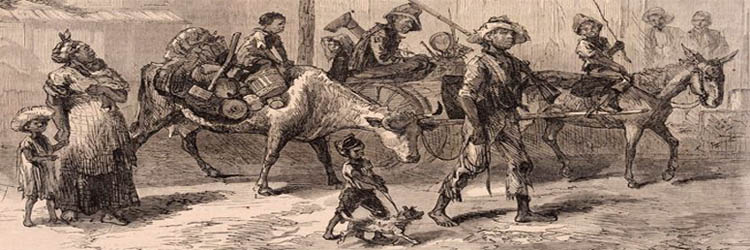
Exodusters En Route to Kansas by Harper’s Weekly, 1879.
In 1866, the railroad connecting Wyandotte with Topeka was completed.
The Kansas State School for the Blind was established in 1867 when the legislature set aside $10,000 to construct the first building, which was completed in October of that year. In March 1868, another $10,500 was set aside until ten children (aged 10–21) were enrolled. In 1877, the school’s name was changed to the “Kansas Institution for the Education of the Blind.” Despite this name, the school was not recognized as a true educational institution; instead, it was operated as a charitable organization. Between 1905 and 1913, the school was run by the Board of Trustees of State Charities and Corrections. In 1913, the school was renamed the Kansas School for the Blind and was recognized as an educational institution. Today, the Kansas State School for the Blind continues to serve students in grades Pre-K through 12
The Kansas City Town Company was organized in 1868 by T. H. Swope, Silas Armstrong, Dr. George B. Wood, David E. James, Luther H. Wood, William Wier, Thomas Ewing, Jr.. and N. McAlpine. John McGee surveyed the town in April 1869, and the plat was recorded with the register of deeds of Wyandotte County on May 3. It was located on a strip of ground between the Kansas River and the Missouri state line. The same year, the first packing house was established by Edward Patterson and J. W. Slavens, with an annual kill of 4,000 animals. However, it was due to Charles F. Adams, a descendant of Presidents John and John Quincy Adams, that Kansas City became a meat-packing center. Adams acquired several large tracts of land in the Kansas River Valley, later occupied by Armourdale and the central industrial district, and built the first of the stockyards. He then persuaded Plankington and Armour to move the packing house they had set up in Missouri to Kansas so that it might be convenient for his stockyards. Around the railroad and packing houses, other towns grew up.
In 1870, the Union Pacific Railroad shops were located in the southern portion of Wyandotte.
Armstrong, on the hill to the south, was established in 1871. Armourdale, named for the Chicago Packers, was founded in the low ground south of Armstrong the same year. Armourdale, situated on the north bank of the Kansas River, about a mile south of its junction with the Missouri River,
Kansas City made rapid progress, and on October 22, 1872, it had sufficient population to be incorporated. The first election was held in October, when James Boyle was elected mayor; S. W. Day, John McKnight, Charles H. Jones, James Lundell and George Forschler, councilmen; Cornelius Cushin, clerk; James Kennedy, police judge; Samuel McConnell, treasurer; and H. L. Alden, attorney. The fire department of Kansas City, Missouri, furnished fire protection for Kansas City, Kansas, until 1882, when a building was erected on James Street to accommodate the police and fire departments.
Across the Kansas River to the south were Rosedale and Argentine. Rosedale took its name from the wild rose covering the bluffs when it was a wayside stop on the Santa Fe Trail. It was platted in 1872 and received impetus from the rolling mill opened in 1875.
Riverview was built on the hill between Armstrong and Wyandotte in 1879.
Armourdale was laid out in 1880 by the Kaw Valley Town Site and Bridge Company, composed of the following Boston capitalists: Charles F. and John Quincy Adams, Charles Merriam, Nathan Thayer, H. H. Hunnewell, and John A. Burnham. The company owned a large tract of land not included in the townsite, which they sold for manufacturing.
Though the need for consolidating these many towns became apparent several years earlier, it was not until 1880 that Riverview petitioned and became part of Wyandotte. In June 1880, the Governor of Kansas, John St. John, proclaimed Kansas City a city of the second class with Mayor McConnell present.
That year, Argentine grew up around the Santa Fe Railway shops and yards and the plant of the Consolidated Kansas City Smelting and Refining Company. The company drew raw materials from all over the country and sent its smelted gold and silver to the mints of the world. Argentine is named from the Spanish word for silver.
In the spring of 1882, Armourdale had a sufficient population to be incorporated, and the first city election was held on May 5, when Frank W. Patterson was chosen the first mayor: Daniel Herbert, Nehemiah Shirrick, and E. W. Anderson. Joseph Bradley and S. Snyder are councilmen; William Ross is marshal; Granville Patterson is clerk; and John C. Foore is police judge.
The Weekly Spy, the town’s first newspaper, appeared the same year. B.M. Brake edited and owned it until 1882, when Charles H. Van Fossen and Felix G. Head bought the Spy and began publishing the Daily Evening Globe on September 5.
In 1883, the street railway was extended to connect Kansas City, Missouri, to Kansas City, Kansas, Armourdale, and Wyandotte, which made the towns practically one regarding transportation and business interests.
On March 27, 1885, the Wyandotte post office name was changed to Kansas City.
Several labor organizations were established in Kansas City early in the 1880s.
Until 1886, the towns west of the Kansas River were a group of independent municipalities. “New” Kansas City, Kansas, was formed by consolidating five municipalities: “old” Kansas City, Armstrong, Armourdale, Riverview, and Wyandotte in March 1886. This move soon quadrupled in population, added to its manufacturing concerns, and multiplied its packing houses. It also had extensive railway repair and construction shops, iron works, factories that turn out hay presses, creamery supplies, tinware, agricultural implements, wagons and carriages, gas and gasoline engines, furniture, foundry supplies, wheelbarrows, wooden boxes and barrels, soap, brick, etc.
By 1890, Kansas City began to take its place as the second-greatest packing center in the country. The stockyards, soap industries, and other manufacturers of by-products were associated with this business.
That decade, the city saw explosive population growth as a streetcar suburb of Kansas City, Missouri.
In 1907, Carnival Park was built on 13.5 acres between 14th and 16th, Barnett and Minnesota. It was named with the idea of a genuine Southern carnival time, when confetti and flowers, reasonable license, and fun mingled. It opened on May 7, 1907. The usual amusement features were a large scenic railway, shooting the chutes over a waterfall, a merry-go-round, billiards, bowling, a moving stairway to great heights, and Indian dances and games. A popular restaurant in the park was called the Wigwam Cafe. Picnic areas were scattered among the tall trees, and there were colorful flower gardens, statues, winding walkways, and daily free band concerts. The park was equal to any amusement park in the West and rivaled only by New York’s Coney Island.
It operated for approximately two years as Carnival Park and was then leased to a carnival for another two years. The demise of Carnival Park is one of the City’s biggest mysteries. No one knows precisely what happened to it and why it failed. Some attribute the failure to the tower’s fall due to high winds. A roller rink adjacent to the tower was damaged by fire. Others believe the Prohibition of serving alcoholic beverages caused a great extent of the problem. Today, the Ward High School grounds cover the area.
In 1910, the city had 25 public schoolhouses and a high school with a manual training department. It also had the College of Physicians and Surgeons, Kansas City University—a Methodist institution—the Kansas City Theological Seminary, and eight Roman Catholic institutions. At that time, it had a population of 82,331 inhabitants.
Argentine became a part of the Kansas City by petition in 1909.
Rosedale was absorbed by Kansas City in 1922 after a legislative enactment forced it in. Meanwhile, Quindaro, having rescinded its incorporation and reverted to Quindaro Township, was absorbed by natural expansion.
Kansas City’s growth continued until the 1930s. It was one of the nation’s 100 largest cities for many U.S. Census counts from 1890 to 1960, including 1920, when it had a population of over 100,000 residents for the first time.
By 1938, Kansas City had 11 packing houses, including those of the Big Four — Armour, Swift, Cudahy, and Wilson requiring the services of seven trunkline railroads. At that time, the city also occupied second place as a milling center in the United States, having the largest hard wheat mills in the world, with a capacity of 5,000 barrels a day.
Kansas City’s population peaked in 1970 at 168,213.
On March 30, 2011, Google announced that Kansas City had been selected as the site of an experimental fiber-optic network that it would build at no cost to the city. Kansas City was chosen from 1,100 U.S. communities applying for the network, which became operational in 2012. The Piper neighborhood became the first full community in the nation to have residential broadband internet infrastructure using fiber-optic communication provided by Google Fiber.
According to the United States Census Bureau, the city has a total area of 128.38 square miles, of which 124.81 square miles is land and 3.57 square miles is water.
Today, Kansas City is the location of the University of Kansas Medical Center and Kansas City, Kansas Community College. It is also home to the General Motors Fairfax Assembly Plant, which manufactures the Chevrolet Malibu and the Cadillac XT4. The Federal Bureau of Prisons maintains the city’s North Central Region Office. In addition, Associated Wholesale Grocers and Kansas City Steak Company are based within the city. The largest employer is the University of Kansas Hospital. The adjoining University of Kansas Medical Center, including the schools of medicine, nursing, and allied health, is also among the city’s largest employers, with a student population of about 3,000.
Village West is a business and entertainment district at Interstate 70 and Interstate 435. Anchored by the Kansas Speedway, tenants include Hollywood Casino, the Legends At Village West, AMC Theatres IMAX, Cabela’s, Nebraska Furniture Mart, Great Wolf Lodge, Monarchs Stadium, the home stadium of the Kansas City Monarchs of the American Association of Professional Baseball, over three dozen restaurants, and Children’s Mercy Park, the home stadium of the Sporting Kansas City Major League Soccer franchise.
Points of Interest:
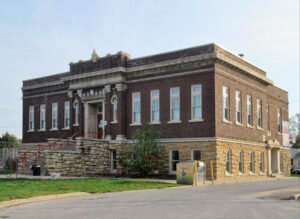
Old Carnegie Library in the Argentine neighborhood of Kansas City, Kansas, courtesy of the Kansas State Historical Society.
Argentine Carnegie Library – The only Carnegie library in the Kansas City metropolitan area was built in 1917. Formerly serving as a Kansas City, Kansas Public Library branch, the library moved its collections and staff from Argentine to the new South Branch at 3104 Strong Avenue. The library has turned over the building to the Kansas City, Kansas, USD 500. It is located at 28th Street and Metropolitan Avenue. It was listed on the National Register of Historic Places in April 1986.
Granada Theater – Located at 1013-1019 Minnesota Avenue, this grand movie palace in Kansas City’s historic downtown is designed in the Mission style with Spanish and Moorish influences. It was built in 1928 and flourished until the 1960s, when the rising popularity of television reduced the profitability of traditional theaters. It was listed on the Register of Historic Kansas Places in February 2005. Small storefronts occupy the eastern and western ends of the facade’s first floor.
Grinter Place – Overlooking the historic Delaware Crossing on the Kansas River, Grinter Place was the home to Annie and Moses Grinter. Annie, a Lenape (Delaware), helped to farm, raise poultry and livestock, and plant an apple orchard. Moses operated a ferry and a trading post, trading with the Lenape Indians. They built this two-story brick house in 1857. Today, the house and grounds function as a state historic site. It was listed on the National Register of Historic Places in January 1971. It is located at 1420 South 78th Street.
Quindaro Townsite – The townsite of Quindaro was initially occupied by Euro-Americans in 1857 and essentially ceased to exist in 1862. However, the area of Quindaro, as it was originally platted, was subsequently settled by African Americans, who saw the establishment of educational and healthcare institutions associated with this same community. It includes 26 major features, including the foundation remains of 20 buildings, two outbuildings, three wells, and one cistern associated with Quindaro Townsite. I was listed on the National Register of Historic Places in May 2002
Rosedale World War I Memorial Arch – Designed by J. LeRoy Marshall, it was erected in 1923. It is dedicated to the men of Rosedale, a neighborhood district and former municipality on the southern edge of Kansas City, Kansas, who served in World War I. Inspired by the Arc de Triomphe, it is located on Mount Marty near Booth and Drexel Streets. A historical marker was dedicated under the arch in 1993 to honor the soldiers of World War II, the Korean War, and the Vietnam War. It is located at 3602 Springfield Street.
Sauer Castle – An Italianate home at 935 Shawnee Road in Kansas City, Kansas; this mansion was built from 1871 to 1873. A ton Sauer, born in Germany in 1823, moved to New York City in 1858, and then, due to his worsening case of tuberculosis, he decided to move his family to Kansas City in 1868. I was listed on the National Register in August 1977
Scottish Rite Temple—Located at 803 North 7th Street Trafficway in Kansas City, Kansas, it was built in 1907-1909. The three-story brick and stone building was the largest meeting place in Kansas City until the construction of the Soldiers and Sailors Memorial Building in 1924. It was listed on the Register of Historic Kansas Places in May 1985. It now serves as the Wyandot Nation’s 7th Street Casino.
Soldiers and Sailors Memorial Building—Located at 600 North 7th Street, it was built in 1925 as a memorial for the soldiers and sailors of World War I and a civic auditorium. It was listed on the National Register in September 1985.
St. Augustine Hall – Located at 3301 Parallel Avenue, it was built as Mather Hall of Kansas City University in 1896 for $30,000. I served the community with distinction but was forced to close in 1933. The Augustinian Recollect Order has preserved the campus and buildings, such as the monastery of St. Augustine, since 1935. I was listed on the National Register in February 1971.
Wyandotte County Courthouse – Located at 710 North 7th Street, the Classical Revival style courthouse was completed in 1927. I was listed on the National Register in April 2002.
Wyandotte High School – Located at 2501 Minnesota Avenue, the Lombardic Art Deco-style building was built in 1936 by the Works Progress Administration. I was listed on the National Register in April 1986.
©Kathy Alexander/Legends of Kansas, updated June 2025.
Also See:
Extinct Towns in Wyandotte County
Wyandotte County Photo Gallery
Sources:
Blackmar, Frank W.; Kansas: A Cyclopedia of State History, Vol I; Standard Publishing Company, Chicago, IL 1912.
Cutler, William G; History of Kansas; A. T. Andreas, Chicago, IL, 1883.
Federal Writer’s Project, Kansas, A Guide to the Sunflower State, Viking Press, New York, 1939.
Kansas Historical Society
Wikipedia


